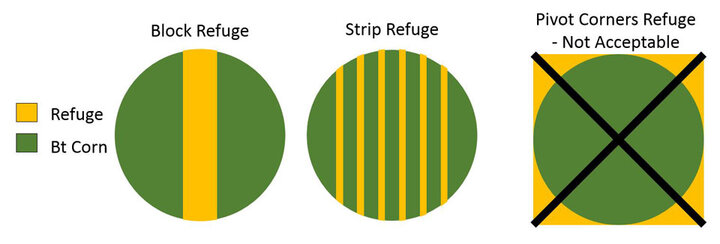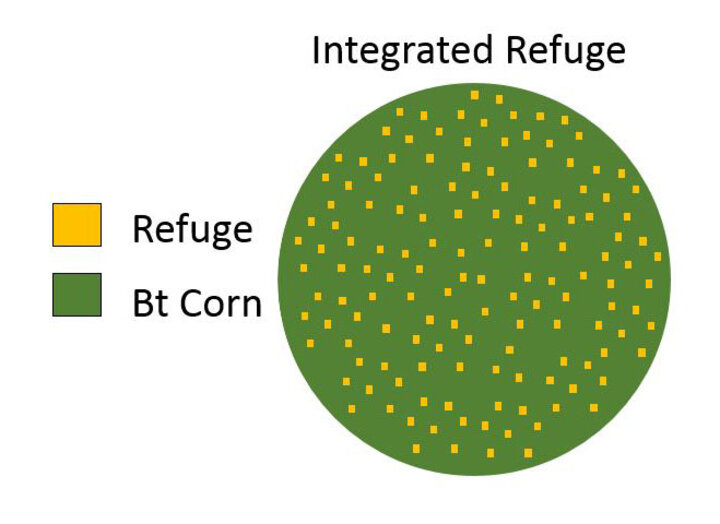Why is Bt Corn Refuge Compliance so Important?
May 29, 2015
For more information on this special CropWatch focus topic see Resistance Management.

Refuges are an important component of resistance management efforts to prevent or delay pest resistance to biotechnology. When planting transgenic Bt corn hybrids on your farm, following refuge requirements is mandated by the Environmental Protection Agency (EPA) and by product stewardship agreements with the seed companies that sell Bt technology. A refuge is simply an area of non-Bt corn; however, the refuge's total area, location, and how it's managed are also important components.
So why is refuge compliance so important and how can it contribute to managing pest resistance and extending the lifetime of Bt products?What is the goal of a refuge?
A refuge is an area of non-Bt corn that has been planted to produce susceptible insects that can mate with any resistant insects that emerge from the Bt crop. An essential aspect of the refuge is that you want to produce insects from this area. This concept may be counter to how growers and ag professionals are used to thinking, given so much effort goes toward reducing the number of insects coming from crop fields rather than producing them. However, in this case we want to produce insects from the refuge area that have not been exposed to Bt proteins and are therefore still susceptible. We want these susceptible insects to far outnumber any potentially resistant insects that emerge from the Bt portion of the field, so that resistant insects are more likely to mate with susceptible insects that were produced by the refuge.
When the Bt crop is high-dose, the offspring of a resistant x susceptible mating will not be able to survive on the Bt product, which limits the spread of resistance in the pest population. If the refuge were not present, then any resistant insects that emerge from the Bt portion of the field will only have other resistant insects to mate with. The offspring of a resistant insect mated with a resistant insect will also be resistant, increasing the number of resistant pests in the population and potentially leading to yield loss and severe difficulties in managing the resistant pest.
Aspects of Refuge Compliance: Acreage and Placement
Acreage
The first step to refuge compliance is understanding the total acreage that must be planted to a non-Bt hybrid. Refuge requirements in Nebraska vary from 5% to 20% of the field. (In the southern US where cotton is grown, refuges may be up to 50%.) Requirements for a given product can be found on the seed bag label or in the Handy Bt Trait Table. For example, the seed bag label shown in Figure 1 requires a 20% refuge. If I plan to plant a 160-acre field, a maximum of 128 acres can be planted to this Bt seed and at least 32 acres must be a non-Bt refuge.
Placement
Deciding where to place a refuge is another important part of compliance. Bt corn targeting corn rootworms must have a refuge that is within or adjacent to the Bt corn, while refuges for traits targeting European corn borer can be up to ½ mile away. This difference is due to the mating behaviors of the two pests; rootworm beetles will not travel far before mating, so the susceptible refuge beetles must be near any resistant beetles emerging from the Bt field. However, corn borer moths will fly longer distances prior to mating and can encounter refuge insects even up to ½ mile away.
Refuge TypesThere are several types of refuges and several ways to place them.
Structured Refuge
Structured refuges can be blocks or strips of non-Bt corn that are located within or adjacent to the Bt portion of the field. A few examples using center-pivot irrigated fields are provided below:


Integrated Refuge
An integrated refuge is planted using a seed mixture of both Bt and non-Bt seed at the appropriate ratio. Refuge-In-A-Bag (RIB) products can be purchased with the refuge seed premixed at the needed rate (typically 5% refuge) and planted normally, resulting in the refuge plants being located randomly throughout the entire field.
Managing the Refuge
The refuge and Bt areas should be managed by the same person and follow identical agronomic management practices, including:
- Crop rotation
- Planting date
- Irrigation
- Inputs: fertilizer, herbicides, and insecticides
- Similar relative maturity
Irrigation can be a particularly important management practice in Nebraska. Pivot corners can not be used as refuges due to the difference in plant and insect development that can occur between dryland and irrigated acreages. If insects do not emerge from the Bt and refuge at the same time to mate, the purpose of the refuge will not be achieved.
Additional Information
- National Corn Growers Association
- Plant & Soil Sciences eLibrary
- Refuge Designs with YieldGard Rootworm Corn, an animated tutorial
- Bt corn grower guides from various seed companies
Julie Peterson
Extension Entomologist
